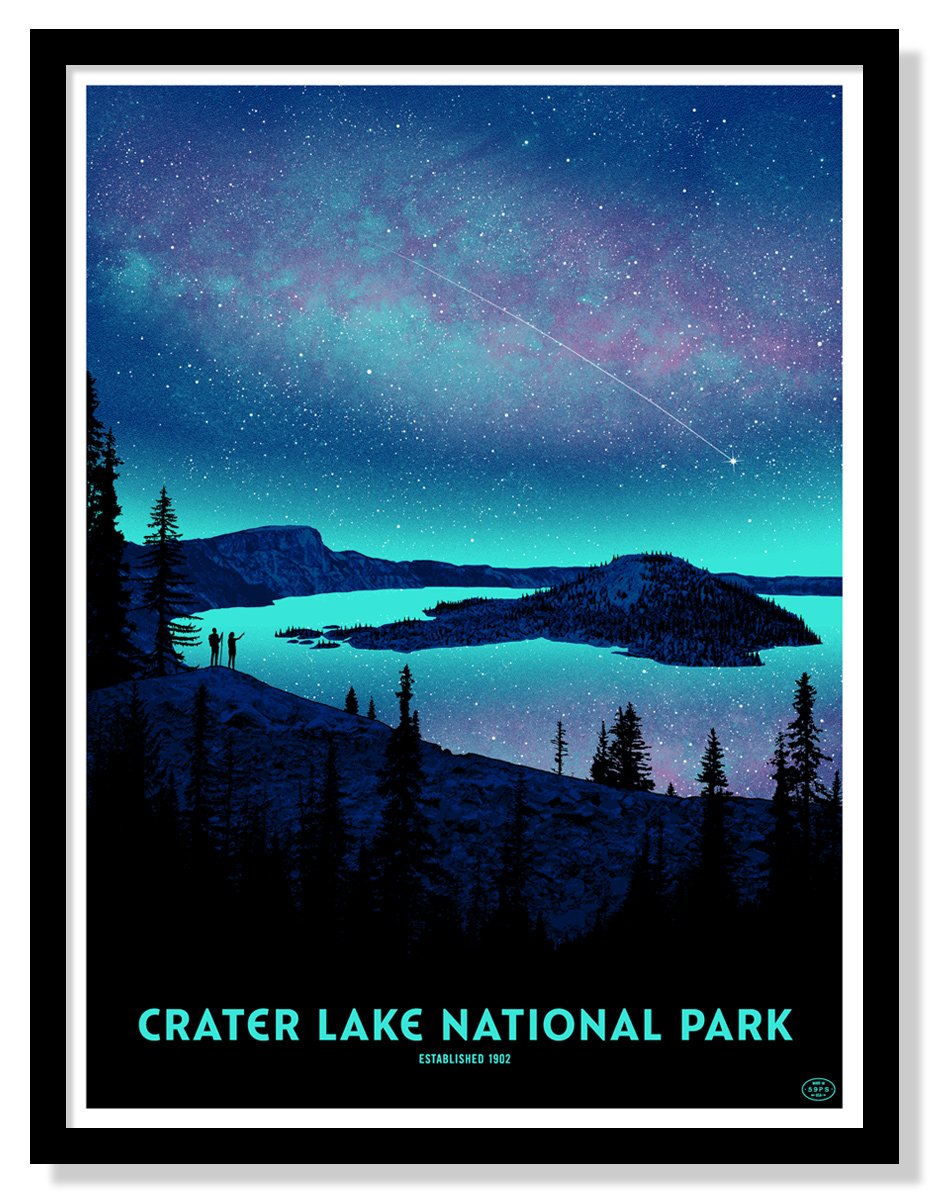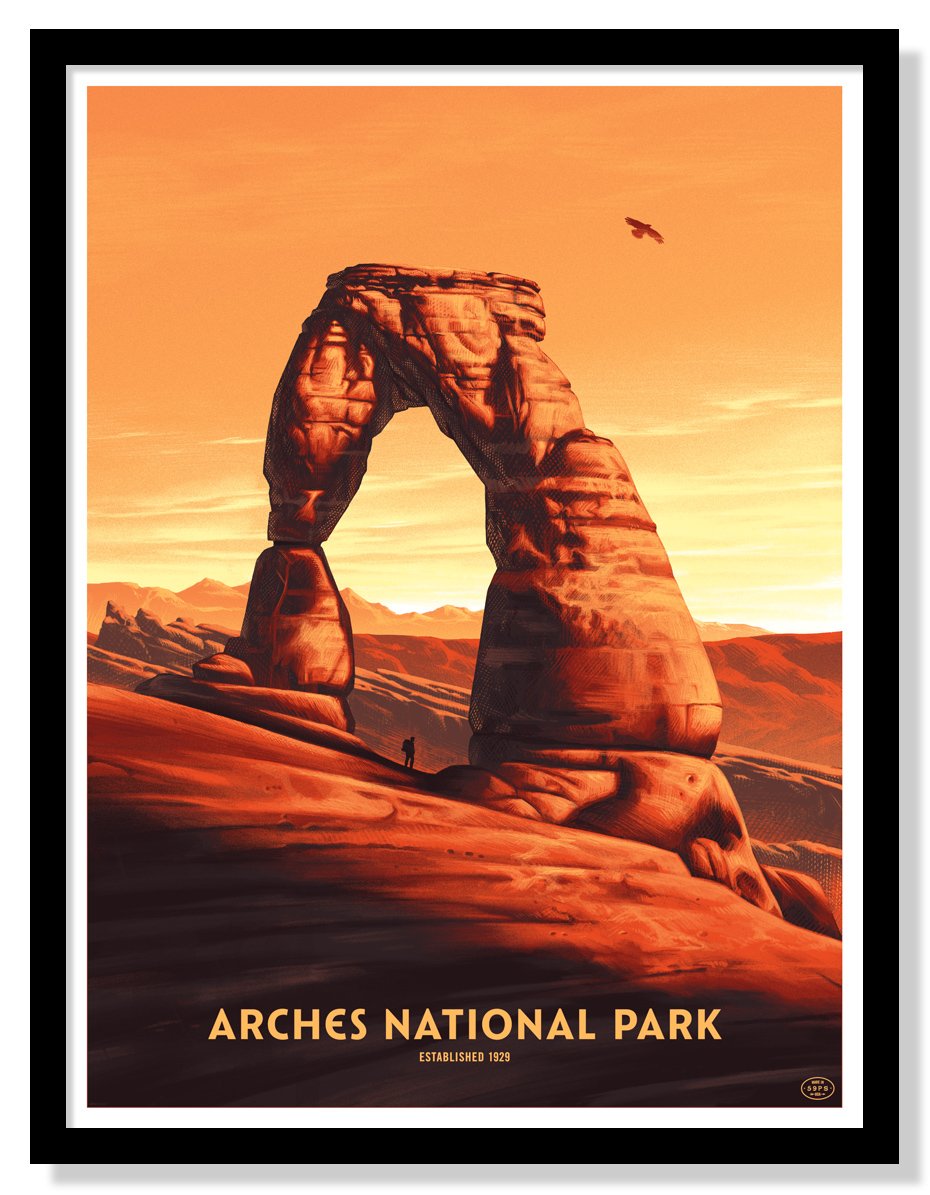Years ago, 19-year-old JP Boneyard visited his first National Park. A musician traipsing the country with his band, Boneyard found himself stopped at the Grand Canyon on the way to a gig.
"Humbling" and "inspiring" were words that came to mind when Boneyard recalled being toes-to-cliff at the park. The beauty and intensity stuck so strongly with the young musician and his group that their passion for national parks coupled with their interest in screen printing bestowed the Fifty-Nine Parks Print Series.
Showcasing original posters of all 63 National Parks created by leading artists from around the world, the founders of Fifty-Nine Parks have always shared a goal to get park fans into posters and poster fans into parks. The full series is currently being archived by the Library of Congress.

Grand Canyon National Park poster by DKNG Studios.
Fifty-Nine Parks was born in 2015. Boneyard and the team struggled a lot the first few years of touring and making ends meet. They would spend half the year on the road doing shows and the other half back home in Austin, Texas, often driving 10 to 14 hours between shows. The creative problem solving and resiliency that this took, Boneyard says, carried over into the poster series for years to come.
“The Art of the National Parks” is the first comprehensive collection of the Fifty-Nine Parks Print Series. The book features stunning posters by leading artists from around the world and includes write-ups and fun facts of all 63 national parks, successfully capturing the authenticity of each place within its pages. Outdoor enthusiasts and art lovers alike can explore the striking scenes of the country’s natural wonders through the eyes of contemporary artists and designers.

The Mount Rainier National Park poster, by Glenn Thomas, is displayed on the cover of “The Art of the National Parks.”
Boneyard writes of the inspiration behind the book in the book’s introduction: “The idea was to work with artists from around the world to celebrate these natural wonders. We set out to highlight the beauty of each park and the unique voice of every artist.”
Five percent of every Fifty-Nine Parks Print Series poster purchase is donated to the National Park Service and similar organizations to help preserve public lands. They have raised over $100,000 to date and intend to continue this work for years to come. The Fifty-Nine Parks team continues to travel the country, visiting all of the national parks; so far, two-thirds have been checked off of the list.
How did a teenager get from a quick stop at the Grand Canyon to a years-long effort to celebrate our nation's most cherished lands? Kinute talked with Boneyard about the journey to this print series and what lies ahead.
Q: What has this book and series meant to you on both a professional and personal level? What positive impacts do you hope it has on the community?
A: The book feels like a great way to encapsulate most of the work from the series. It's an accessible way for people to take home a little piece of every park. On a personal level, it's something my late grandfather would be very stoked on. That means a lot to me! The series overall has just been a dream come true! It's really rewarding to do work that you feel is meaningful. I hope the community will feel inspired to visit the parks and check out the work of each artist. It'd be awesome if the book—and the series—inspire folks to pursue something creative and dig deeper into their connection with nature!

Crater Lake National Park poster by Dan McCarthy.
What is the first National Park you visited? What do you remember most about the experience and how did it change your life?
Grand Canyon was the first National Park that I visited. When I was 19—friends and I were on a cross-country tour playing music. Grand Canyon happened to be on our way to the next show. It blew our minds. When you consider how much time went into creating that epic canyon—it really helps a young person leave with some much-needed perspective. We left the park humbled and inspired to learn more about the natural world. For a young person who never really left New England, this experience fed my desire to see what other inspiring places were out there!

Sequoia National Park poster by Glenn Thomas.
You mention that the goal of Fifty-Nine Parks is "to get park nerds into posters and poster nerds into parks.” What do you think designers and artists can gain from national parks and the experiences they offer? And what can outdoor enthusiasts and parkgoers gain from the prints?
Designers and artists are often glued to their screens. Unplugging for a while can be immensely helpful to the creative process. Not to mention the parks are pretty dang inspiring. It's hard not to leave a park seeing the world in a different way. The same can be said about parkgoers spending some time with the prints. Art can often help us see the world in a different way, too. There's something special that people can pick up on with each of the posters. An artist has spent 20-40 hours illustrating a scene from a park in great detail. That sense of shared reverence—between the artist and the parkgoer—is something special. From my own experience, it's just the simple joy of seeing a park like Big Bend each day on my office wall. I smile when I realize—all over again—that this place actually exists! I also think back to who I went there with and how awesome that experience was. And then I'm inspired just knowing how much hard work Brave the Woods put into that poster.

Biscayne National Park poster by Justin Santora.
What was the creative process behind pairing each artist with each park?
We're very intentional about many of the creative decisions with the series. We aim to highlight an artist's interests and strengths when we pair them with a park. It's even better if we know that an artist has been to that particular park—at that point it feels like a really inspired fit all around! Ultimately, we look to celebrate the eclectic mix of the parks with the unique voice of each artist. Pairing artists with each park is a lot of fun—there are so many variables to consider!

Joshua Tree National Park poster by Little Friends of Printmaking.
What has your experience been like working with so many artists (either featured in the Fifty-Nine Parks print series or elsewhere)?
I've learned something from every artist in the series. It's such a joy—and a privilege—to collaborate and see their process! We've worked with hundreds of artists going back to 1999. So many bands, designers, and visual artists have made a tremendous impact on me. Working with folks who have sacrificed and worked so hard on their craft is just inspiring—it keeps the wind in our sails. Talking shop and bouncing ideas off of one another is amazing, too! Any time someone believes in you—and vice versa—I feel like that has a very special impact.

Big Bend National Park poster by Brave the Woods.
You mention in the introduction of the book that you used to screen print on your bedroom floor. Can you explain the printing process? What makes it so compelling/fascinating?
Screen printing is essentially the use of a stencil to make multiple prints of the same design. Our stencil uses a fine mesh that is stretched over a metal or wooden frame. Each color of the design is contained on a different screen. We print one color at a time—going from darkest to lightest—to build up the design. There's something so nice about the way the ink stacks up on top of each layer. There's a wonderful, tactile quality to a screen-printed poster. Even though the medium allows you to reproduce the same image over and over, there are little eccentricities that make each print unique. Going back to our days of setting up 30-plus DIY music events a year—we couldn't afford color printing for our show posters-- the best way to stand out was to screen print your own posters. That meant we could work larger than 11-by-17 inches, and we could work with three to five colors instead of just one color on the photocopier. Screen printing is such a fun, accessible medium!

Arches National Park poster by Nicolas Delort.
The Fifty-Nine Parks Print Series has been quite a journey. What was the biggest struggle the team faced?
We had our fair share of struggles during our first years with the series. The good thing is we are able to learn from each challenge and grow. Perhaps the least glamorous struggle is the most persistent: bandwidth. This has been a challenge for us even back when we were putting in 65+ hours a week—working seven days a week—without any sort of time off. Our work / life balance is in a great spot now but we're still a small team—and we want to stay small. That means we often have a ton of fun ideas but we don't have the time needed to make them all a reality. Time can be a stick in the mud in this regard, but it can also be our friend. We'll get to where we're going eventually. The journey is the most important part of this experience. We're just grateful to be here.

The Pacific Crest Trail poster by Chris Turnham.
What takeaways do you have for designers who wish to build their own collaborative design projects?
Under promise and over-deliver. That goes back to our days booking bands. We'd identify the realistic outcome of a show—share an estimate with bands and venues that were a little lower—and aim way higher. That way no one is disappointed. Transparency on how things are run and just following through on your word is crucial. It doesn't hurt to pay people as soon as you get an invoice—or before one is even sent. We love working with a variety of different artists. We also learned that back in the day. If you book a show with four bands who all share the same audience—your attendance isn't going to be as large—or as diverse—than if you booked four different types of bands who have different audiences. This isn't weird for the sake of weird—it's really just more interesting—and has more potential for something special. That approach is definitely a part of why the print series has become what it is at this point.

Banff National Park poster by Kim Smith.
Now that this book is out, what’s next?
We have some fun things in the works! Some really exciting collaborations and a new mini-series. There's also something cooking around a new game and a children's book! We look forward to sharing more about each in 2022!
For more information on the book, visit "The Art of the National Parks." Stay in tune with Fifty-Nine Parks by following @fiftynineparks on Instagram.
